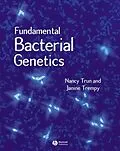Fundamental Bacterial Genetics presents a concise introduction to microbial genetics. The text focuses on one bacterial species, Escherichia coli, but draws examples from other microbial systems at appropriate points to support the fundamental concepts of molecular genetics.
A solid balance of concepts, techniques and applications makes this book an accessible, essential introduction to the theory and practice of fundamental microbial genetics.
* FYI boxes - feature key experiments that lead to what we now know, biographies of key scientists, comparisons with other species and more.
* Study questions - at the end of each chapter, review and test students' knowledge of key chapter concepts.
* Key references - included both at chapter end and in a full reference list at the end of the book.
* Full Chapter on Genomics, Bioinformatics and Proteomics - includes coverage of functional genomics and microarrays.
* Dedicated website - animations, study resources, web research questions and illustrations downloadable for powerpoint files provide students and instructors with an enhanced, interactive experience.
Autorentext
Janine E. Trempy, Ph.D., is an Associate Professor of Microbiology and the Associate Dean in the College of Science at Oregon State University. She has received numerous research and teaching awards from Oregon State University, and in 1996 she was named by the Carnegie Foundation/CASE as Oregon Professor of the Year for her development and use of innovative inquiry based cooperative learning environments. She was a Waksman/American Society for Microbiology Traveling Lecturer, presenting lectures focusing on science education reform. Her research focus is on bacterial crisis management systems, microbial applications (i.e. biosensor development; food safety) and developing inclusive learning environments that enhance science literacy.
Nancy Trun is an Assistant Professor in the Dept of Biological Sciences at Duquesne University where she teaches undergraduate and graduate level microbial genetics. She has taught microbial genetics courses at the University of Maryland and at Cold Spring Harbor Laboratory and received the National Institutes of Health Director's Award for science education at the elementary school level. Currently, her research focus is on chromosome folding in bacteria.
Zusammenfassung
Fundamental Bacterial Genetics presents a concise introduction to microbial genetics. The text focuses on one bacterial species, Escherichia coli, but draws examples from other microbial systems at appropriate points to support the fundamental concepts of molecular genetics.
A solid balance of concepts, techniques and applications makes this book an accessible, essential introduction to the theory and practice of fundamental microbial genetics.
- FYI boxes - feature key experiments that lead to what we now know, biographies of key scientists, comparisons with other species and more.
- Study questions - at the end of each chapter, review and test students' knowledge of key chapter concepts.
- Key references - included both at chapter end and in a full reference list at the end of the book.
- Full Chapter on Genomics, Bioinformatics and Proteomics - includes coverage of functional genomics and microarrays.
- Dedicated website animations, study resources, web research questions and illustrations downloadable for powerpoint files provide students and instructors with an enhanced, interactive experience.
Inhalt
1. Introduction To The Cell.
The Molecules That Make Up A Cell.
The Bacterial Cell: A Quick Overview.
How Do Cells Grow?.
What Is Genetics?.
Summary.
2. The Bacterial Dna Molecule.
The Structure Of DNA And RNA.
Deoxyribonucleosides And Deoxyribonucleotides.
DNA Is Only Polymerized 5' To 3'.
Double-Stranded Dna.
Supercoiling Double-Stranded Dna.
Replication Of The Escherichia Coli Chromosome.
Constraints That Influence Dna Replication.
The Replication Machinery.
Dna Polymerases.
Dnag Primase.
Replication Of Both Strands.
Theta Mode Replication.
Minimizing Mistakes In Dna Replication.
The Dna Replication Machinery As Molecular Tools.
Summary.
3. Mutations.
Phenotype And Genotype.
Classes Of Mutations.
Point Mutations And Their Consequences.
Measuring Mutations: Rate And Frequency.
Spontaneous And Induced Mutations.
Errors During Dna Replication: Incorporation Errors.
Errors Due To Tautomerism.
Spontaneous Alteration By Depurination.
Spontaneous Alteration By Deamination.
Alterations By Spontaneous Genetic Rearrangement.
Alterations Caused By Transposition.
Induced Mutations.
Chemicals That Mimic Normal Dna Bases: Base Analogues.
Chemicals That React With Dna Bases: Base Modifiers.
Chemicals That Bind Dna Bases: Intercalators.
Mutagens That Physically Damage The Dna: Ultraviolet Light And Ionizing.
Radiation.
Mutator Strains.
Reverting Mutations.
Suppression.
Ames Test.
How Have We Exploited Bacterial Mutants.
Summary.
4. Dna Repair.
Lesions That Constitute Dna Damage.
Reverse, Excise Or Tolerate?.
Mechanisms That Reverse Dna Damage.
Photoreactivation.
O6-Methylguanine Or O4-Methylthymine Methyltransferase.
Mechanisms That Excise Dna Damage.
Uvrabc Directed Nucleotide Excision Repair.
Muthls Methyl Directed Mismatch Repair.
Very Short Patch Repair.
Glycosylases.
Uracil-N-Glycosylase Coupled With Ap Excision Repair.
Deaminated Bases Removed By Dna Glycosylase.
Alkylated Bases Removed By Dna Glycosylase.
Mutm/Muty: Oxidative Damage.
N-Glycosylases Specific For Pyrimidine Dimmers.
Mechanisms That Tolerate Dna Damage.
Transdimer Synthesis.
Post Replication/Recombinational Repair (Prr).
Introduction To The Sos Regulon.
Summary.
5. Recombination:.
Homologous Recombination.
Models For Homologous Recombination.
The Holliday Or Double-Strand Invasion Model Of Recombination.
An Alternative To The Holliday Model: The Single Strand Invasion Model Of Meselson And Radding.
Further Enzymatic Considerations.
Site-Specific Recombination.
A Typical Site-Specific Recombinational Event.
Bacteriophage l:A Model For Site-Specific Recombination.
Other Examples Of Site-Specific Recombination.
Illegitimate Recombination.
Summary.
6. Transposition.
The Structure Of Transposons.
The Frequency Of Transposition.
The Two Types Of Transposition Reactions.
The Transposition Machinery.
The Transposition Machinery; Accessory Proteins Encoded By The Transposon.
The Transposition Machinery: Accessory Proteins Encoded By The Host.
Non-Replicative Transposition.
Replicative Transposition.
Does The Formation Of A Cointegrate Predict The Transposition Mechanism?.
The Fate Of The Donor Site.
Target Immunity.
Transposons As Molecular Tools.
...